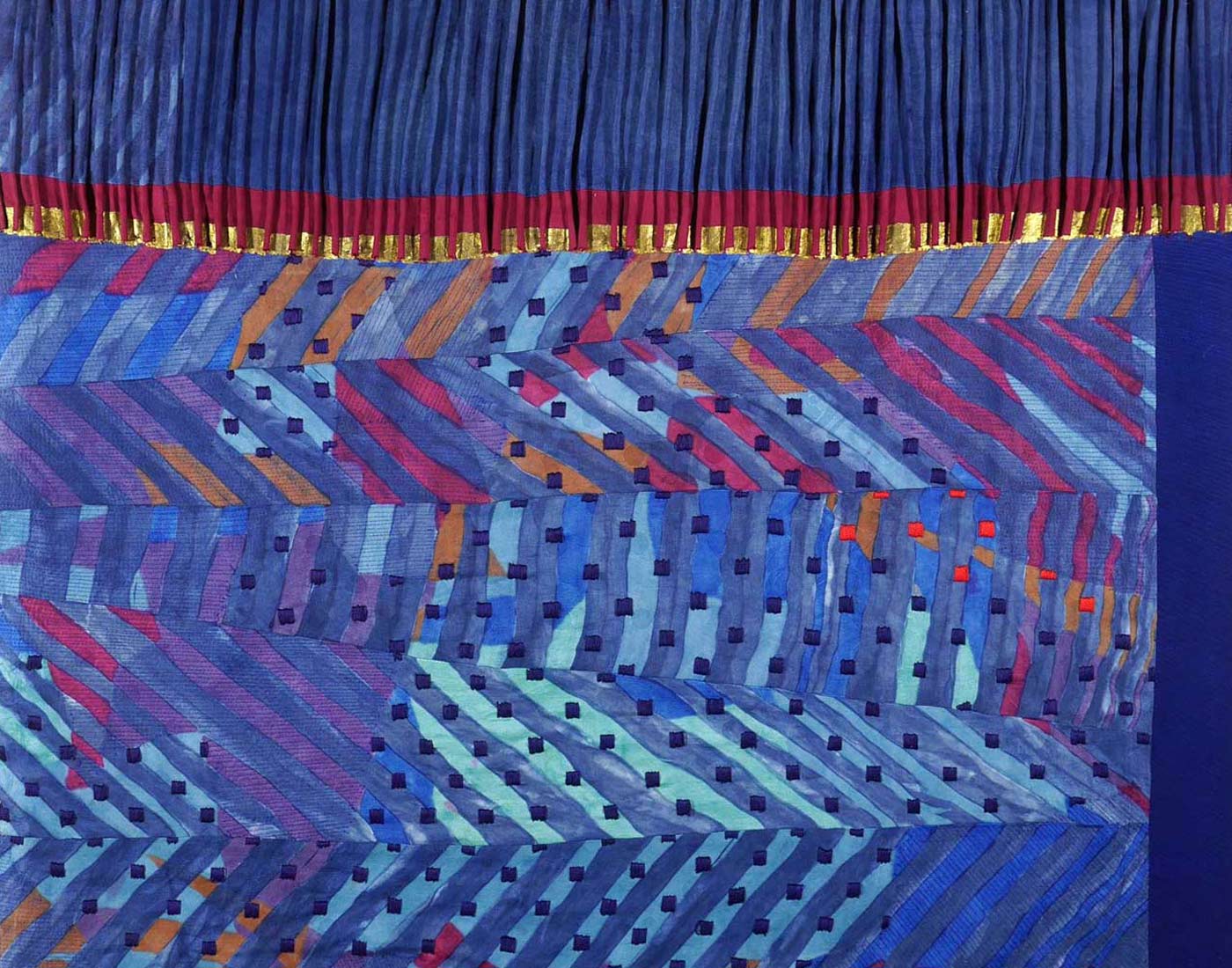
Anne Lindberg, Twilight Garden Blue (detail), 1988, Fabric and ink, 44 x 48 in, Gift of ASG Technologies, Collection of FGCU Art Galleries
Open to Interpretation:
Selections from the Permanent Collection
Wasmer Art Gallery
August 29 - October 3, 2019
Opening Reception and Curator's Talk - Thursday, August 29, 5 -7pm
In celebration of new donations to the FGCU Art Galleries, guest curators are invited to activate the FGCU Permanent Collection through their own lens. As part of the Seidler Fellowship, FGCU student Farrah Alkhadra (junior, Art) will research and curate an exhibition alongside a display of recent gifts and other works never displayed before, including sculptures, paintings and prints.
Sponsored by Gene and Lee Seidler, the State of Florida, Department of State, Division of Cultural Affairs and the Florida Council on Arts and Culture and WGCU Public Media
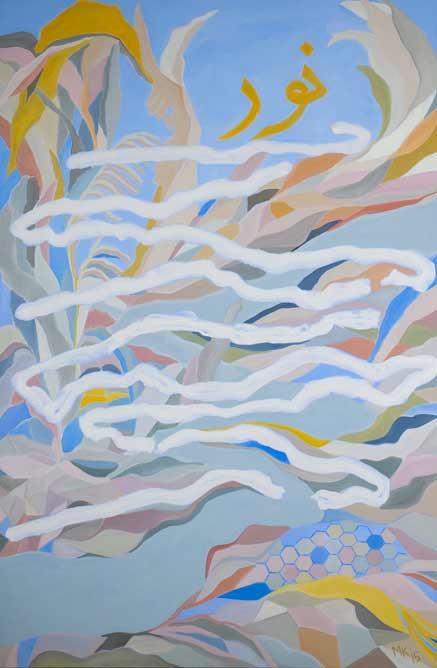
Mally Khorasantchi, Roots of Feeling VIII (detail), 2015, 72x48 in., Oil on canvas, Gift of Artist, Collection of FGCU Art Galleries, 2019.0001.0001.
Unexpected Forms
by Farrah Alkhadra
 Arturo Alonzo Sandoval, Ground Zero #7, c.1990, Textile, 55 in. round, Gift of ASG
Technologies, Collection of FGCU Art Galleries, 2016.0003.0064. Photo by Farrah Alkhadra.
Arturo Alonzo Sandoval, Ground Zero #7, c.1990, Textile, 55 in. round, Gift of ASG
Technologies, Collection of FGCU Art Galleries, 2016.0003.0064. Photo by Farrah Alkhadra.
Unexpected Forms features artists that work with paint, paper, plant fiber, photographs, metal, ceramics, and wood. This exhibition creates links between these materials and processes by showing their shared utilization of the grid in both visual composition and physical structure. The literal and figurative process of weaving is also evident throughout the exhibition. During the curatorial process a number of the works required research and conservation. This was an important part in understanding the history and processes behind the pieces.
This exhibition is drawn from The FGCU Art Galleries’ Permanent Collection, primarily from a donation by ASG Software Solutions, along with a work donated by Carol Littleton-Shay and a piece from Art in State Buildings. These collections contain painting, printmaking, sculpture, textiles, and ceramics. Of the over one hundred and sixty works from these collections, nine were selected. These works were chosen in order to show shared qualities; that of alternative weaving, sculptural techniques, and use of the grid. The pieces stretch the literal constraints of “textile” and “collage” to form visual narratives that are conceptually linked.
The works were made by artists who have a mutual understanding of weaving, pattern, and color. They break conventions and offer new ideas based on these shared concepts and principles. While these artists and their works are extremely varied, they coincide at intersections of method and process. They also draw on a variety of cultural traditions of the Mayans, Native Americans, and the Colonial Spaniards. These cultures and others introduced specialized methods and signature nuances to their textiles. For example, Ziek’s method of weaving within her piece was influenced by traditional Mayan weavings. Ziek says, “The brocading is done, pick by pick...I learned this technique of supplementary weft when I lived in Guatemala and studied with Mayan weavers on backstrap looms.”
Some pieces in this exhibition are newly displayed without a case or frame, which ultimately alters the way they are viewed. Bhakti Ziek’s Sugar Blues was originally framed, as were many of the works in the exhibition. The frames served the needs of ASG’s Corporate Offices but diminished the pieces’ materiality. Decisions were made during the initial curatorial process that aimed to enhance and emphasize the physicality of the works.
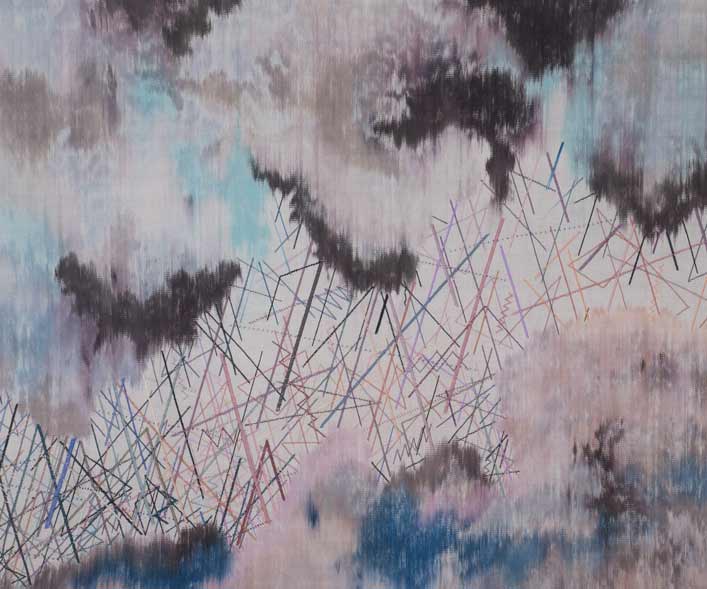 Bhakti Ziek, Sugar Blues, 1980, Woven Textile, 55x64.5 in., Gift of ASG Technologies, Collection of FGCU Art
Galleries, 2016.0003.0073. Photo by Farrah Alkhadra.
Bhakti Ziek, Sugar Blues, 1980, Woven Textile, 55x64.5 in., Gift of ASG Technologies, Collection of FGCU Art
Galleries, 2016.0003.0073. Photo by Farrah Alkhadra.
This exhibition also includes the manipulation of paper and photography. Arturo Sandoval, Tom Nakashima, and Mark Templeton use paper and photography in their pieces creating a sculptural, illusionary effect. Shifts in perspective and distance alter the perception of the viewer. Mark Templeton’s paper woven piece, Multilevel Structure , has similar connotations to Twilight Garden Blue by Lindberg, in that both artists employ a recognizable herringbone pattern. Although both works are different in medium and execution they use similar visual language. More visual similarities are evident in the displayed pieces by Nakashima and Sandoval, specifically, the use of grids or squares repeating in their pieces.
Upon first glance, Sandoval’s repetitive use of photography goes unnoticed due to the piece’s abundance of materials. Strips of photography are woven with intentional neon stitching intersecting the warps and wefts in Sandoval’s piece, Ground Zero 7. Here, moments of weaving build the foundation of the larger work, accenting the pattern and contributing additional frames of complexity to the overall texture.
Sandoval is culturally influenced by his Colonial Spanish and Native American (Tano) heritage. Sandoval’s work was prompted by two hundred and fifty years of weaving present in his family history. Sandoval’s piece also demonstrates use of alternative materials, weaving techniques, and the use of the grid.
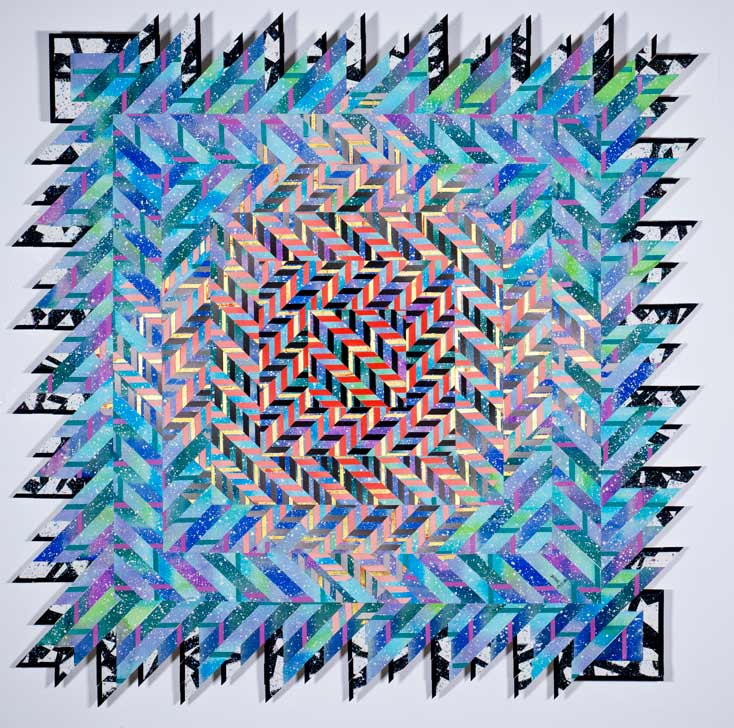 Mark Templeton, Multilevel Structure c.1990, Paper/watercolor collage, 35.5x35.5
in., Gift of ASG Technologies, Collection of FGCU Art Galleries, 2016.0003.0082.
Photo by Farrah Alkhadra.
Mark Templeton, Multilevel Structure c.1990, Paper/watercolor collage, 35.5x35.5
in., Gift of ASG Technologies, Collection of FGCU Art Galleries, 2016.0003.0082.
Photo by Farrah Alkhadra.
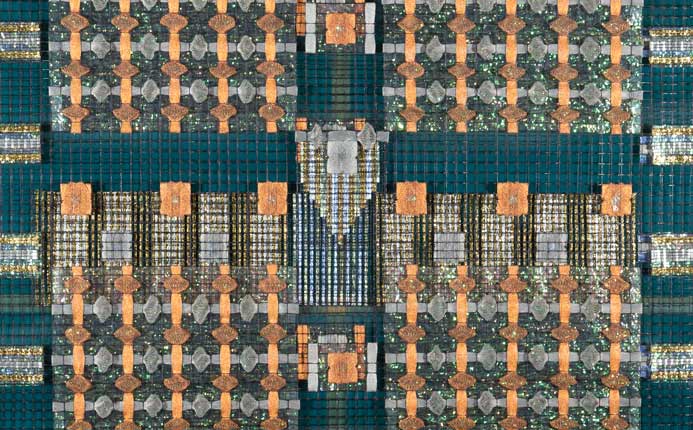 Joyce Crain, Logic Array detail (from the Microchip Series) c.1990, 44x55 in., Wire
grid, ribbon on fabric, Gift of ASG Technologies, Collection of FGCU Art Galleries,
2016.0003.0084. Photo by Farrah Alkhadra.
Joyce Crain, Logic Array detail (from the Microchip Series) c.1990, 44x55 in., Wire
grid, ribbon on fabric, Gift of ASG Technologies, Collection of FGCU Art Galleries,
2016.0003.0084. Photo by Farrah Alkhadra.
Unexpected Forms exposes the viewer to materials and techniques that challenge the definition of mark making. The featured artists take similar approaches to making art, allowing for an exciting combination of works to be seen. If not for the opportunity to display these pieces together, the complex network of associations between them would remain unknown. In essence, this exhibition stimulates a relationship between expected and unexpected forms of expression.
Student/Faculty Undergraduate Scholarly Collaboration Fellowship
Unexpected Forms marks the first time an FGCU student has been invited to research the Permanent Collection and curate an exhibition from it. This opportunity was made possible from the Seidler Fund supporting Student/Faculty Undergraduate Scholarly Collaboration Fellowships, which has supported many FGCU students and faculty in compelling research across the disciplines. Farrah Alkhadra and John Loscuito co-wrote a proposal to spend ten weeks over the summer researching the Permanent Collection and curating an exhibition. Her resulting exhibition and essay provide a fresh and exciting perspective on works in the collection, some of which have never been publicly exhibited.
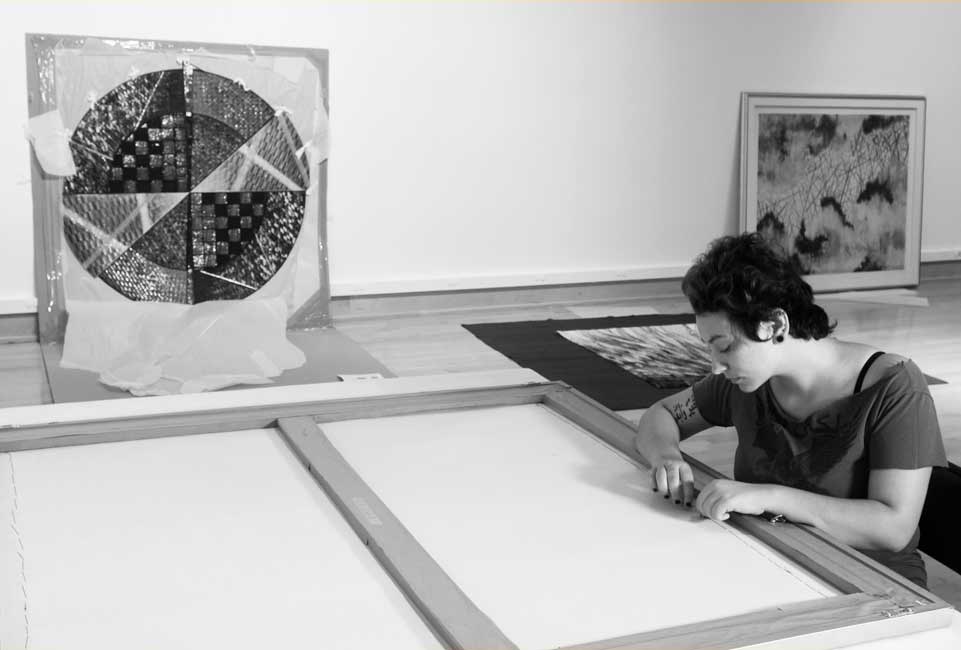
Art Major and Gallery Assistant, Farrah Alkhadra, removes Twilight Garden Blue from its frame in preparation for the conservation/restoration work needed for the piece.
